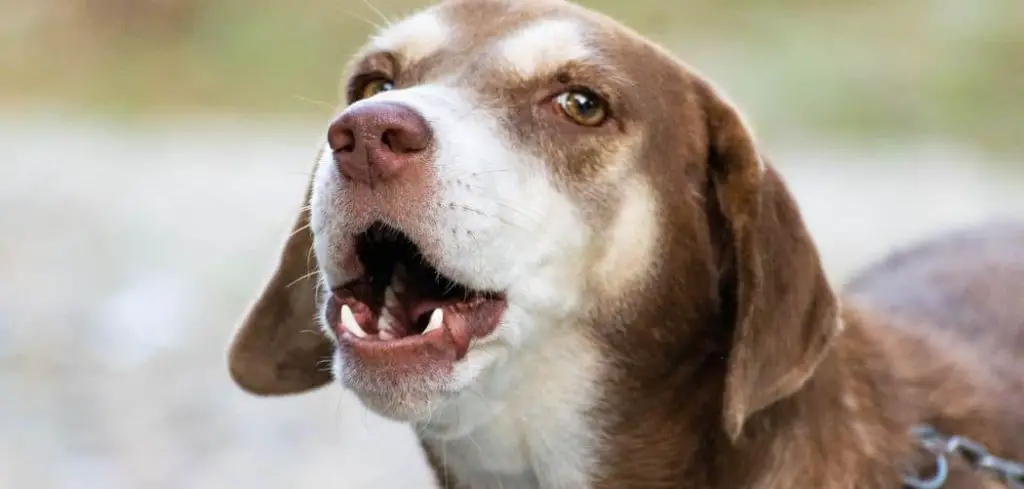Panting paired with growling can be a sign that your dog is experiencing discomfort. While growling is a natural form of canine communication, when combined with heavy or rapid panting it may indicate illness that requires careful attention.
We outline the common causes of dog panting and growling, what you can do at home, and when to seek veterinary help.
Dog Panting and Growling — Why It Happens
Dog panting and growling often happen together when a dog feels threatened, anxious, or in pain. The panting is a physical response to stress or discomfort, helping to release excess heat and tension, while the growling is a vocal warning meant to communicate fear, defensiveness, or irritation.
This combination can occur during stressful situations—such as encountering strangers, other animals, or loud noises—or when the dog is experiencing pain from an injury or illness.
If your dog growls and pants without an obvious trigger, it may indicate internal discomfort or neurological issues that need veterinary evaluation.

Dog Panting and Growling: Common Causes
Anxiety or Fear
An anxious dog may pant and growl as a warning or coping mechanism. Panting increases oxygen intake and helps regulate stress hormones, while growling communicates discomfort or a desire for distance.
Common triggers include loud noises, unfamiliar people or animals, separation from owners, or changes in the home environment.
Signs often include trembling, pacing, lip licking, or hiding. Chronic anxiety can affect appetite, sleep, and overall well-being, making it important to address behavioral stressors promptly.
Read more: Dog Panting and Gulping (What it could mean)
Pain or Injury
Dogs in pain often exhibit both panting and growling as a response to discomfort. Pain from arthritis, injuries, dental issues, or internal illness can make a normally calm dog more irritable and prone to growling.
Owners might notice limping, stiffness, sensitivity to touch, or reluctance to move. Pain-related behaviors are serious because untreated discomfort can worsen over time and impact a dog’s quality of life. Prompt evaluation and treatment can relieve suffering and prevent further complications.
Illness or Fever
Underlying medical conditions such as infections, fever, or systemic illness can cause dogs to pant and growl. Fever increases body temperature, leading to rapid panting, while discomfort or malaise may trigger growling.
Other signs may include lethargy, loss of appetite, vomiting, or diarrhea. Medical causes should never be ignored, as early diagnosis can prevent serious health consequences and improve recovery outcomes.
Aggression or Territorial Behavior
Growling accompanied by panting may indicate territoriality or aggressive behavior, especially in the presence of other animals or strangers. Dogs use growling to assert boundaries, and panting can occur due to excitement, stress, or physiological arousal.
Signs include stiff body posture, direct staring, raised hackles, and lunging. Recognizing the context of these behaviors is critical to prevent escalation and ensure the safety of both pets and people.
Neurological or Cognitive Disorders
Neurological conditions such as brain tumors, seizures, or cognitive dysfunction can lead to unusual behaviors like panting and growling. Dogs may appear confused, disoriented, or reactive in situations that normally wouldn’t trigger these behaviors.
Additional symptoms can include circling, head tilts, unsteady gait, changes in sleep patterns, or decreased responsiveness. Neurological causes are often serious and require timely veterinary assessment for diagnosis and treatment planning.
Heatstroke or Environmental Stress
Panting is the primary way dogs cool themselves, and combined with growling, it may indicate distress from overheating. Heatstroke can be triggered by prolonged exposure to hot weather, confinement in warm spaces, or vigorous exercise without access to water or shade.
Symptoms include excessive drooling, rapid breathing, weakness, vomiting, and confusion. Heatstroke is a medical emergency; rapid cooling and immediate veterinary care are essential to prevent organ damage or death.
What to Do If Your Dog Is Panting and Growling
Move your dog to a calm and safe environment away from perceived threats or stressors. Reducing environmental stimuli can help lower stress levels and minimize panting and growling.
Offer small amounts of water if your dog is panting heavily, but avoid forcing fluids. Hydration is essential, particularly if panting is due to heat or illness.
Observe your dog for additional signs such as limping, head tilting, vomiting, or behavioral changes. Keeping a log of these symptoms can assist your veterinarian in identifying the underlying cause.
Avoid attempting to physically restrain a dog that is growling, as this may escalate aggression. Instead, use calm verbal reassurance and allow your dog space to relax.
Monitor your dog’s overall behavior, appetite, and activity level. Early detection of changes, particularly in older dogs, can help address pain, cognitive decline, or medical conditions before they worsen.
When to Call or Visit Your Vet
Seek immediate veterinary attention if panting and growling are accompanied by collapse, fainting, labored breathing, blue gums, or uncontrolled aggression.
Contact your veterinarian if your dog shows signs of pain, fever, vomiting, diarrhea, or sudden behavioral changes. Even mild but persistent symptoms may indicate underlying medical or neurological issues.
Older dogs or those with pre-existing conditions should be evaluated promptly, as age-related cognitive or neurological disorders can exacerbate these behaviors.
Veterinary assessment is also crucial if panting and growling occur suddenly in a normally calm dog, or if these signs escalate in frequency or intensity.
Read more: Dog Panting and Grunting (Here’s why)
Key Takeaway
Panting and growling together can be caused by anxiety, pain, illness, aggression, neurological disorders, or heat stress. While occasional growling is normal communication, repeated or severe panting combined with growling should prompt careful observation and evaluation.
Providing a calm environment, monitoring for additional symptoms, offering water, and reducing stress can support your dog at home. Prompt veterinary assessment is essential if symptoms are persistent, severe, or accompanied by other concerning signs.
Recognizing these behaviors early and responding appropriately helps protect your dog’s health, comfort, and safety, ensuring they receive timely care and maintain a better quality of life.
